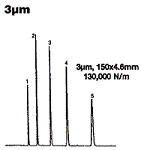Long columns are typically 25cm in length, providing increased efficiency and resolution over shorter columns. Long columns increase retention time and backpressure.


Short columns (5cm) can provide adequate resolution and high speed of analysis, especially in HPLC/MS. Short columns should be considered for fast method development.
Typical HPLC column lengths are 5, 10, 15 and 25cm.
The most common particle size for speed and resolution in analytical columns is 5µm. Smaller particle sizes such as 3µm can increase resolution and speed by using shorter columns.


Back pressure is increased with smaller particles and selectivity is not affected. Narrow particle distribution will increase column efficiency.
The most common column I.D. is 4.0 - 4.6mm. The optimum flow rate is 1.0 to 1.25mL/min. Narrowbore columns (2.0 to 3.0mm) have optimum flow rates of 0.2 - 0.6mL/min, which saves solvent consumption and improves sensitivity.
Columns of 1.0mm (microbore) or smaller require flow rates of 10 - 50µl/min. Microflow injectors, pumps and low volume detector flow cells are necessary to optimize the performance of microbore or packed capillary HPLC columns.


Small I.D. columns may increase sensitivity, however, they may decrease efficiency and resolution. Semi-prep (10mm) and Prep HPLC (20mm to 4"+) columns require flow rates of 10 - 20+ mL/min. of solvents. Repacking of prep
columns is available.
The smaller the pore size, the larger the surface area. Increased surface area allows for increased carbon loading. Small sample molecules are best analyzed by 80 - 150Å pore size particles. Peptides, proteins and other macromolecules are best analyzed by 300 - 1000Å pore size particles.


Small pore size distribution will increase column performance.







